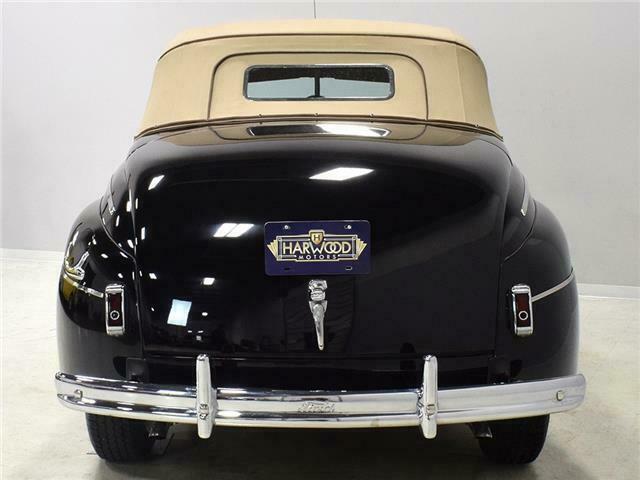1941 Ford Super Deluxe Convertible 39644 Miles Black 239 cubic inch V8 3-speed
- Condition: Used
- Make: Ford
- Model: Super Deluxe Convertible
- Type: --
- Trim: --
- Year: 1941
- Mileage: 39644
- VIN: 186572305
- Color: Black
- Engine size: 239 cubic inch V8
- Power options: --
- Fuel: Gasoline
- Transmission: Manual
- Drive type: --
- Interior color: Tan
- Options: --
- Vehicle Title: N/A
- Location: Local pick-up only
Description
There's no such thing as a bad flathead Ford, but some rise to the top simply because everything comes together just right. This purposeful-looking 1941 Ford Super Deluxe convertible is such a car. We can't quite call it stock because there are a few modifications, but it isn't radical and it would be easy to turn it into a high-quality OEM car without a lot of work. I think that would be a mistake, because it features a very high-quality... black paint job, a sweet-running flathead, and a gorgeous interior with a new top. If you've wanted a turn-key old car, this is an excellent choice. Basic black was always Henry Ford's favorite, and we suspect that the no-nonsense look of this striking convertible would suit him just fine. At a glance, it appears to be totally stock, and it is except for the stance—it's lowered slightly and has a bit of a rake to it. Nothing radical or even requiring major surgery to reverse, but it certainly adds some attitude. The restoration is perhaps 8 or 10 years old, but it has been out of circulation for the last few years, so there aren't many miles on it at all. The glossy black finish shines up beautifully and it's obvious that they started with quality base stock because we can detect no patches, bondo work, or other questionable issues under the skin. It really is as straight and shiny as it appears. The doors fit well, the fenders are bolted on with correct welting, and even the trunk lid locks down neatly. The only real demerits are some minor scratches around the rear wheel openings because this car came to us wearing fender skirts—we didn't like them so we removed them, although they are included with the sale if you'd like to reinstall them. Despite some good rubber seals, they did leave a few marks. But beyond those minor issues, the car is quite spiffy. The tan leatherette interior is likewise quite authentically done, right down to the rubber floor mat in front and carpets in back. The upholstery is very recent and shows almost no signs of use, and all of the soft parts were replaced, including the door panels. The woodgrained dash is quite well done and all the factory ivory knobs are in place and they all work properly. Factory gauges monitor the warmed-over flathead, and even with a 12-volt electrical system, they all work including the ammeter. There's an auxiliary Stewart Warner oil pressure gauge under the dash that's probably a bit more accurate than the original, and we like the vintage look. Obviously with a 12-volt electrical system, the radio and clock are offline, but that's not unusual. Accessory spotlights are installed but not wired, but that would be a fun Saturday project. Overhead there's a brand new tan canvas top that's just beautifully fitted—no wrinkles or creases, and it powers up and down properly, albeit slowly. A matching tan boot gives it a finished look and we love the contrast with the black paint. The trunk is also restored with a black rubber mat and a correct full-sized spare on a matching black steel wheel. The flathead V8 under the pointed hood is a later 59AB unit with 239 cubic inches and a few period upgrades, most notably the aluminum Offenhauser heads and the triple carburetors up top. We'll tell you up front that the car is currently running on only the center carburetor—that's how we got it and it runs so beautifully that we are hesitant to change anything. You could get the others working with a fuel block and a linkage, both of which are commonly available, and it would surely add some punch. We love that it uses a 12-volt generator for an authentic look, as well as OEM hose clamps and Ford script hoses. Only the bright yellow plug wires really betray the period in which it was built, and a set of correct Ford multi-colored cloth wires would be the perfect finishing touch to this engine bay. The ignition system itself uses a later aftermarket "crab" distributor and an upgraded coil, and with 12-volts spinning the starter, it fires almost instantly. Out on the road it feels very much like any pre-war flathead, with decent power, smooth acceleration, and a great exhaust note from the dual exhaust system. Nothing radical or special, just a cool look that you could take up a notch pretty easily if you wanted. Underneath, the chassis is exceptionally clean. Aside from some water marks that are far more visible in the camera flash than in person, it is almost completely unmarked. Beautiful floors are finished in the same gloss black as the bodywork and there's zero evidence of rust. Yes, it has been driven, but there's no question this was a quality restoration. The 3-speed manual transmission and 3.55 gears are stock 1941 pieces, and it's happy to burble along at 55 MPH without any complaints. It still runs the original axles and springs, so it has that frisky Ford handling and the stock 1941 Ford brakes are hydraulic, so they're reasonably powerful for the car's performance. Smitty glasspack-style mufflers give it just the right sound and it sits on restored steel wheels with trim rings and hubcaps, as well as a set of modern 225/75/15 radials that ride and handle great. We've had a number of these and this might be our favorite. Maybe it's the sinister look or the period performance parts, but this is one of those rare cars that will probably be welcome anywhere—purists and hot rodders can appreciate many aspects of the car. It drives great, it's bulletproof reliable, and you can easily take it up a notch or two with just some light elbow grease. But if this were mine to keep, I'd leave it alone and just go have fun. That's what flatheads do best. Call today!
 1965 Ford Mustang GT Convertible 75489 Miles Black 289 cubic inch V8 3-speed a
1965 Ford Mustang GT Convertible 75489 Miles Black 289 cubic inch V8 3-speed a
Mileage: 75489
 1940 Ford Deluxe Convertible Coupe 22206 Miles Bright Red 350 cubic inch V8 3-
1940 Ford Deluxe Convertible Coupe 22206 Miles Bright Red 350 cubic inch V8 3-
Mileage: 22206
 1936 Ford Deluxe Cabriolet 63491 Miles Blue Convertible 239 cubic inch V8 Manua
1936 Ford Deluxe Cabriolet 63491 Miles Blue Convertible 239 cubic inch V8 Manua
Mileage: 63491
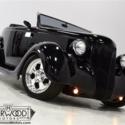 1936 Ford Roadster 266 Miles Black 350 cubic inch V8 3-speed automatic
1936 Ford Roadster 266 Miles Black 350 cubic inch V8 3-speed automatic
Mileage: 266
 1932 Ford Roadster 4860 Miles Black 350 cubic inch V8 4-speed automatic
1932 Ford Roadster 4860 Miles Black 350 cubic inch V8 4-speed automatic
Mileage: 4860
 1941 Ford Super Deluxe 57248 Miles BLACK 239ci V8 3-Speed Manual
1941 Ford Super Deluxe 57248 Miles BLACK 239ci V8 3-Speed Manual
Mileage: 57248
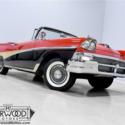 1958 Ford Fairlane 6555 Miles Torch Red/Raven Black Convertible 352 cubic inch
1958 Ford Fairlane 6555 Miles Torch Red/Raven Black Convertible 352 cubic inch
Mileage: 6555
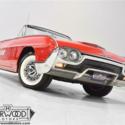 1963 Ford Thunderbird Convertible 46414 Miles Red 390 cubic inch V8 3-speed au
1963 Ford Thunderbird Convertible 46414 Miles Red 390 cubic inch V8 3-speed au
Mileage: 46414
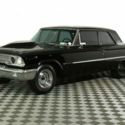 1963 FORD GALAXIE 4,615 Miles BLACK 289 CUBIC INCH
1963 FORD GALAXIE 4,615 Miles BLACK 289 CUBIC INCH
Mileage: 4615
 1955 Ford Fairline Crown Victoria 6688 Miles Raven Black 292 cubic inch V8 Aut
1955 Ford Fairline Crown Victoria 6688 Miles Raven Black 292 cubic inch V8 Aut
Mileage: 6688








